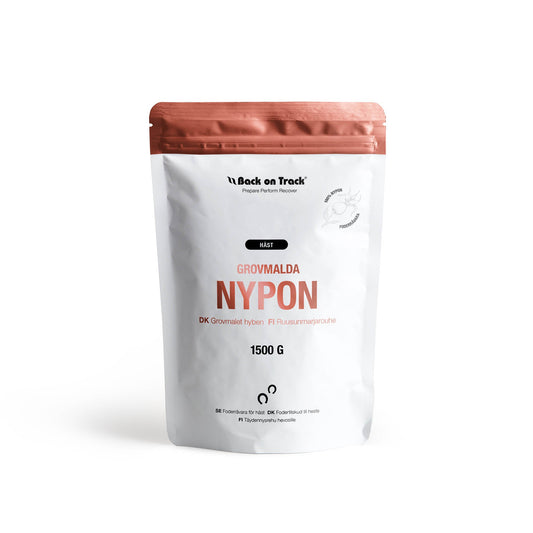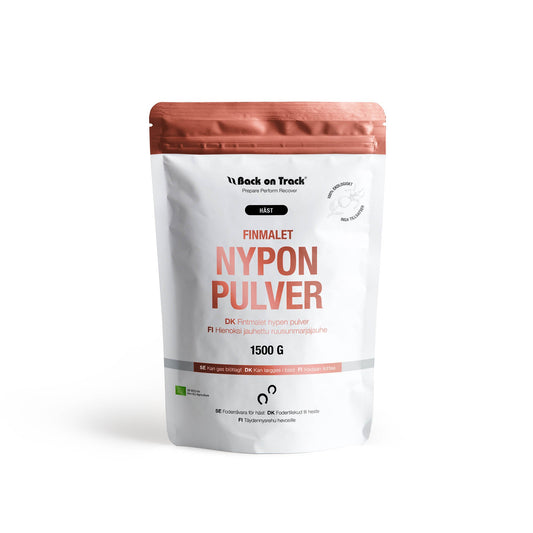Rosehips for Horses
People have been feeding rosehips to horses at least since the Middle Ages to fortify their diet - but also because rosehips seemed to have noticeably positive effects on their well-being. Traditionally, rosehips were considered particularly beneficial for the horse's joints, cartilage and mobility. It is only now, in modern times, that science is beginning to catch up and can offer explanations based on research.
Feed material in Nature's luxury edition
The wild rose bush is an efficient biological factory that produces a variety of health-promoting substances. Vitamins, flavonoids, tannins, essential fatty acids and other organic molecules are transported to the accessory fruits where they are concentrated, turning them into a superfood. Some, like beta-carotene and lycopene, give rosehips their intense, orange-red colour. Others give them their characteristic taste and astringent mouth feel.
Many of these substances are exceptionally useful in the body as nutrients and/or antioxidants. The shiny pseudo-fruits have indeed been found to contain a cocktail of more than a hundred biologically active substances with health-promoting properties. As knowledge of the body has increased, analytical methods have improved and biochemical research has progressed, more and more substances have been identified and their health effects mapped. As a result, rosehip products have also received a welcome and highly justified boost - for both humans and animals.
Known effects on joint mobility
Rose hips are suitable for all horses and benefits their health by supporting the normal function of tissues and the normal activity of the immune system. The feed material can be given to active horses to prevent joint problems, as well as to promote recovery or help alleviate stiffness and joint problems in older horses.
The rosehips' content of glycolipids gives them their anti-inflammatory properties. This protects the cartilage in the joints against inflammatory processes, and can counteract the swelling that occurs in osteoarthritis. Reduced discomfort allows the horse to move and work with greater ease. When the horse puts stress on its joints, the nutrient-rich synovial fluid circulates in the cartilage, supplying it with oxygen and nourishment. This lubricates the cartilage and builds it up.
Rosehips are also rich in antioxidants, which help the body defend itself against the reactive molecules that otherwise wear down tissues, accelerate cellular ageing and increase the risk of inflammation. Vitamin C is a potent antioxidant, and horses have been shown to absorb natural vitamin C from rosehips far more efficiently than by synthetic vitamin C supplements alone.
Which rosehip products should I choose?
Back on Tracks rose hips for horses are available in coarse ground form, as fine rosehip powder and as pellets. The content always consists of 100% wild grown rosehips without additives. The rosehips are of high quality and carefully dried to preserve nutrients and vitamins.
Horses like rose hips a lot and will eat them in whatever form they are served. Rosehip pellets make an excellent treat! The pellets are easy to portion out as they do not seep through the feed or stick to the inside of the crib. Both the coarse and fine ground rosehip powder should preferably be soaked and mixed with other feed.
Finely ground powder has a sweeter taste which some horses appreciate. Other horses may appreciate the chewiness of rose hip pellets. However, powdered rose hip is particularly suitable for older horses who may have problems with both teeth and joints.
Time of the rosehip
Towards autumn, the red-orange rosehips start to shine in the midst of the thorns, difficult to pick - and utterly useful. Looking at the contents, the shiny little nuggets ought to be the most desirable produce of harvest time. Yet for long periods they have more or less fallen into oblivion. Harvesting and preparing them is hard work. When there is abundance, it is easy to turn from the demanding rosehips to something more convenient.
However, in hard times, we have been reminded of the plentiful resources growing in the wild. During the Second World War, rosehips were widely exploited for their vitamin C content. They provided a much-needed dietary supplement for people during periods of rationing; the vitamin C content of rose hips far exceeds that of oranges.
The wild rose (Rosa canina) is a thorny, climbing shrub with great vigour and hardiness. Consequently, it has managed to take root in large parts of the world. It can be seen forming large thickets, which for a few summer weeks are covered with their perishable, pale pink flowers. The short flowering time and simple flowers have made other, flashier varieties popular as cultivated plants. The roses adorning the flower beds of today often have bright colours, pronounced fragrance and full, multipetaled flowers.
Rosehips for beauty and health
But for a very long time, the wild rosebush reigned supreme in the landscape. It was also this variety that was considered a medicinal plant and was cultivated in monastic gardens, as a cure for all kinds of ailments.
In folk medicine, the rosehips have been used as a remedy for joint problems, stiffness and aches, as well as the whole range of symptoms we now know are caused by vitamin C deficiency. This is attested to by a long cultural history, which loses itself in a distant past. Probably the Vikings already realised that they could avoid scurvy by carrying rose hips on their long journeys - although they did not know why.
This is also the way in which the rosebush spread to South America: via sailors from Europe, probably as early as the 16th century. The roses greatly appreciated their new surroundings and spread rapidly in the poor soil where no other agriculture could be practised.
They still thrive at high altitudes in the pure nature of the Chilean Andes. This is also the place where the rosehips grow, which ultimately become our horse feed. Chile now accounts for a considerable part of the world's rosehip production. It has become an important source of income for the local population and a major export product.











